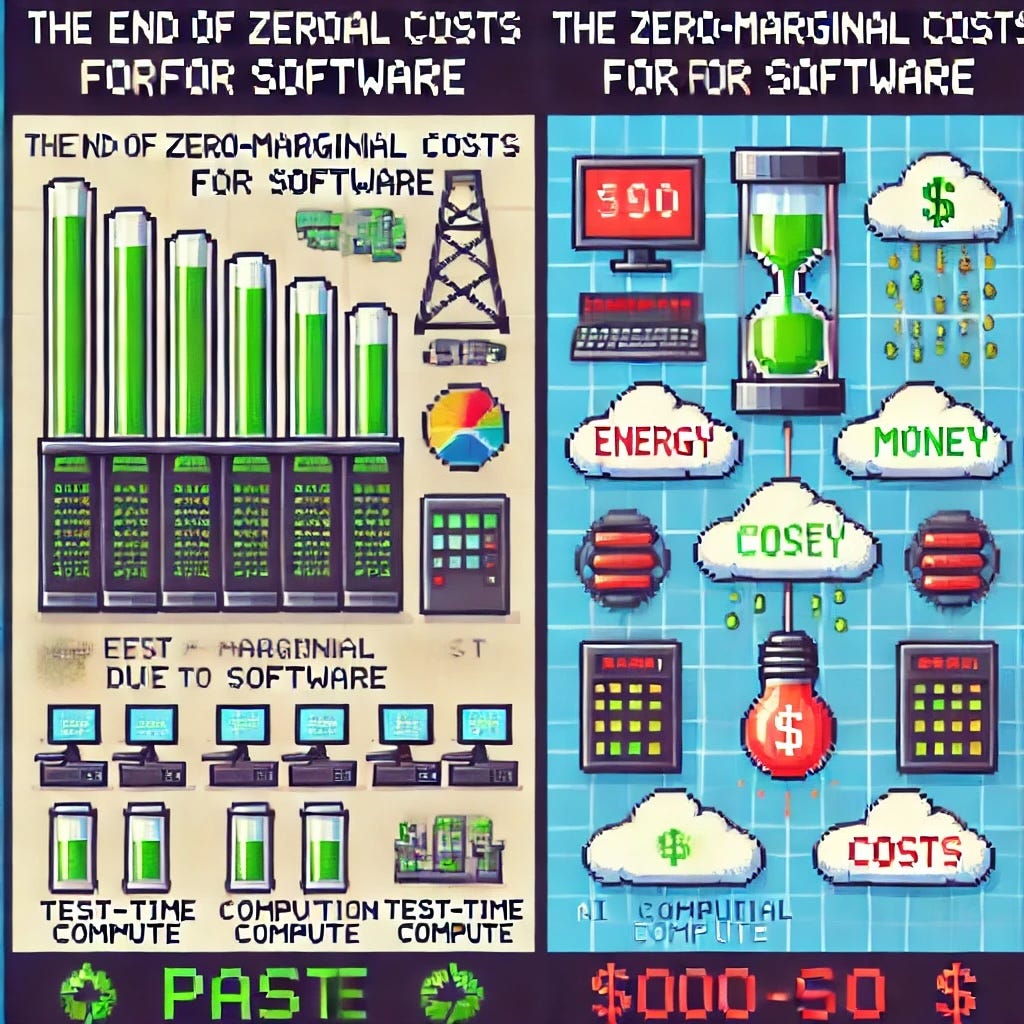the end of zero-marginal costs + the end of your ai fund
Short post to test a thesis, tell me what I'm missing?
This image makes no sense but on the surface looks sort of right, right? Welcome to the Terrordome. It’s a metaphor for AI btw. I’m sure you get it.
What up? Last week I said the Magnificent Seven have an advantage in the next leg of AI build out because test-time compute introduced operating costs. Test-time compute remember is using runtime to compute to come up with a better response instead of exclusively using the training data. Test-time compute is basically what will enable practical agents to do stuff on the Internet.
My claim is that venture capital as an asset class is less attractive than *it used to be* [can’t include timeline without more research]. Because:
Higher interest rates
Longer time to IPO
AI has a better risk-adjusted return profile in the public markets than private markets
I want to explain number three because it’s the load baring argument.
TL;DR
AI investing is closer to deep tech than Internet/SaaS investing over the past 20 years. The shift to reasoning-heavy AI models introduces significant operating expenses at scale, challenging the traditional software valuation playbook. While higher revenues may offset some costs as agents replace human labor, startups face massive challenges: higher opex, lower margins, and intense competition from incumbents. VCs (we) need to adapt or risk suboptimal returns. But considering the amount already invested, it’s likely the returns are already in the post. Good luck out there.
1. Historical Context
In the era of internet services and mobile apps, computational processes during user interactions were lightweight. Google Search and Facebook News Feed relied on pre-built indexes, efficient algorithms, and cached data. This allowed these businesses to scale globally at near-zero marginal cost, leading to incredibly high gross margins (often 75%-80%). The economics of SaaS followed a similar trajectory, with relatively low customer acquisition costs (CAC) and high annual contract values (ACVs), creating a highly scalable model. It was the best of times.
2. The AI Transition: From Capex to Opex
Old World: Between 2018 and 2024, AI scaling followed the pre-training scaling law, which was capex-intensive. Larger models, trained on massive GPU clusters, dominated the landscape, but inference costs were relatively modest. Models like GPT-3 and Claude were built for static inference: once trained, the computational burden of serving each query was manageable.
New World: From 2024 onwards, basically o1 and now o3, a shift emerged: post-training scaling laws emphasized runtime compute. Techniques like chain-of-thought (CoT) reasoning, retrieval-augmented generation, and adaptive inference increased performance but required significantly more computation per query. While these approaches improved reasoning and decision-making—core features for AI agents—they also introduced a meaningful, recurring opex burden for each user interaction.
3. Linear or Near-Linear Scaling Costs
Unlike SaaS, where incremental user costs approach zero at scale, reasoning-heavy AI systems incur meaningful costs for every user or request. Inference costs no longer fall neatly into the background but instead rise in proportion to usage. Serving billions of users becomes proportional to the compute needed, fundamentally altering the scaling economics.
Evidence
1. Compute-Heavy Models
OpenAI’s o3 is claimed to cost upwards of $1,000 per query for the most intensive reasoning modes. While this is likely an outlier tied to early experimentation, it underscores the growing burden of runtime compute. Even optimized production models may require custom silicon and aggressive cost management to remain viable.
2. Incumbent Strategies
Companies like Google, Meta, Amazon, and Microsoft are already pursuing vertical integration across silicon (Google is way ahead with their 7th generation of TPU) hardware (data centers, cooling), and applications. By tightly controlling their infrastructure, they can cut inference costs significantly, giving them a competitive edge. There has been a decisive shift to vertical integration for AI away from horizontal plaforms (“aggregators”) in the Internet and Mobile eras. Startups, lacking these advantages, are likely to pay higher per-query costs for public-cloud compute, further squeezing their margins.
Implications for AI Startups
1. Higher Operating Costs
Startups will need to contend with significantly higher ongoing costs to serve customers, particularly for reasoning-intensive applications like agents, enterprise workflows, and real-time decision-making systems. Gross margins, traditionally strong in SaaS, may compress to levels seen in lower-margin industries like media or professional services (20%-30%).
2. Valuation Compression
Lower gross margins will likely result in reduced valuations. Traditional SaaS companies might achieve a 10x revenue multiple with ~75% margins, but AI startups with ~30% margins could trade closer to 5x revenue. This shifts the target for unicorn status from ~$100m ARR to potentially ~$200m ARR, raising the bar for success.
3. Capital Intensity
To achieve meaningful scale, AI startups will require larger funding rounds earlier in their lifecycle. Seed investors face greater dilution, and Series A and B rounds will likely balloon to $50m-$150m. Startups unable to secure these resources will struggle to compete, particularly against incumbents who can cross-subsidize AI ventures with revenue from other business lines.
VC Strategy Adjustments
1. Increased Ownership at Seed
To offset dilution in later rounds, VCs need to secure higher ownership stakes (~25%-30%) at the seed stage. This ensures that even with dilution, they maintain meaningful participation in eventual winners. But with higher valuations because FOMO and broad consensus that TAM is massive, it’s hard to execute on this as the medium fund.
2. Larger Portfolio Size
Given the reduced probability of success due to increased competition and cost challenges, VCs should expand their portfolio size for AI investments. This could mean backing 30-50 companies per fund to increase the likelihood of hitting a major winner. Again, hard to execute on in the middle of a fund investment period. This can only be viable for new funds yet to close. This would result in average fund size increasing to secure increased ownership at seed in more companies.
3. Focus on Capital Efficiency and Margins
I mean this is the obvious one. But I feel like I have to keep banging the drum. VCs must scrutinize startups’ opex structures early, favoring those that demonstrate clear paths to cost reduction or premium pricing power. Growth-at-all-costs strategies are less viable when gross margins are constrained. This means we should see more CFOs in founding teams and founders with strong financial management skills. This is broadly seen as something that can be brought in at B, but to stand out a disiplined focus on margins when scaling will be crucial.
Ergo, AI has a better risk-adjusted return profile in the public markets than private markets. As AI investing moves into its next phase, the economics of test-time compute introduce significant headwinds for private-market venture capital. Compressed margins, capital intensity, and incumbent competition all conspire to lower the risk-adjusted return potential for private AI startups. While there are undoubtedly opportunities for exceptional founders and disruptive companies to emerge, the balance of risk and reward increasingly favors the public markets, where investors can participate in AI’s growth with significantly lower operational exposure.
Right? So, Fund Frontier Expeditions otherwise just buy the "Magnificent Seven".
Where the Thesis Could Be Wrong
1. Breakthrough Cost Reductions
Algorithmic advancements—such as quantization, pruning, or early-exit techniques—could *dramatically* reduce test-time compute requirements. Similarly, the development of more efficient hardware (custom silicon, Etched.ai, Rain.ai, etc) could shift the cost curve downward. Obviously it won’t stay as $1,000 per query. But still, any cost means there is a marginal cost.
2. Emergence of Specialized Use Cases
Not all AI applications require reasoning-heavy inference. This is probably the strongest argument. Vertical solutions targeting enterprise markets (e.g., legal AI, financial AI) may generate high ACVs with lower inference demands, resulting in stronger margins. These vertical-specific businesses may be the best investments. It might end up that applications that use heavy reasoning have higher opex than those that don’t. This maps neatly to salaries I suppose. e.g. salaries are a higher % of revenues for software companies than retail.
3. Revenue Potential From Agents
If AI agents replace skilled human labor, the value they deliver may justify premium pricing. For instance, an AI agent costing $10k/year in compute but replacing a $100k/year employee could generate robust margins, even with high opex. This couldn’t disprove the core argument that opex will matter, but just that revenue can be higher.
What am I missing? Please get in touch and tell me why I’ve got wrong here or what I am discounting.






one banger after another - legend
Very interesting. One of the challenges of the startup ecosystem is the traditional challenge with finance: a very limited historical perspective. Most of the people who stick around have grown wildly successful, and most of those who got blown up are out of the game. I enjoyed the insight into how a shift from low/no marginal cost will be a sea change, and think you are dead on. Thanks for sharing.